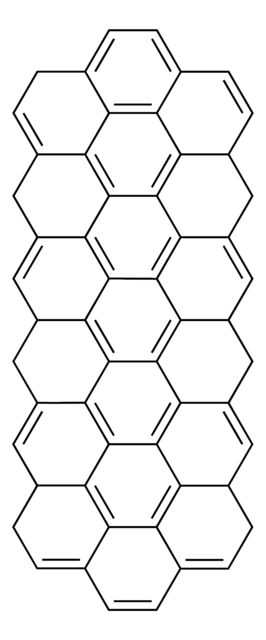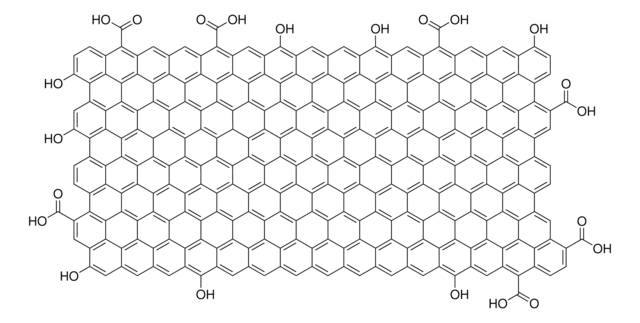About This Item
Polecane produkty
Próba
≥90.0% carbon basis (TGA)
Formularz
powder
dł. × szerokość
2-15 μm × 40-250 nm
gęstość
2.2745 g/mL (He gas method)
gęstość nasypowa
0.0970 g/mL (Mercury Porosimetry)
Szukasz podobnych produktów? Odwiedź Przewodnik dotyczący porównywania produktów
Opis ogólny
Zastosowanie
- Composites.
- Conductive inks.
- Electrodes for LiB.
- Energy storage & harvesting applications.
- Bio-medical applications.
- Preferred dispersing organic solvents: pyrrolidones and chlorinated solvents.
- Less preferred dispersing organic solvents: cyclohexanone and γ-butyrolactone.
- Aqueous dispersions are possible at 0.1mg/mL with triton-X-100, sodium cholate and deoxycholate and cellulose-based surfactants.
Komentarz do analizy
ID/IG = 0.65±0.07
I2D/IG = 0.74±0.03
2D FWHM = 63 cm-1
Informacje prawne
Hasło ostrzegawcze
Danger
Zwroty wskazujące rodzaj zagrożenia
Zwroty wskazujące środki ostrożności
Klasyfikacja zagrożeń
Carc. 2 - Repr. 2 - STOT RE 1 Inhalation
Organy docelowe
Lungs
Kod klasy składowania
6.1C - Combustible acute toxic Cat.3 / toxic compounds or compounds which causing chronic effects
Klasa zagrożenia wodnego (WGK)
nwg
Wybierz jedną z najnowszych wersji:
Certyfikaty analizy (CoA)
Nie widzisz odpowiedniej wersji?
Jeśli potrzebujesz konkretnej wersji, możesz wyszukać konkretny certyfikat według numeru partii lub serii.
Masz już ten produkt?
Dokumenty związane z niedawno zakupionymi produktami zostały zamieszczone w Bibliotece dokumentów.
Produkty
Graphene is a unique two-dimensional (2D) structure of monolayer carbon atoms packed into a dense honeycomb crystal that has attracted great interest due to its diverse and fascinating properties.
Since its discovery little more than a decade ago,1 the two-dimensional (2D) allotrope of carbon—graphene—has been the subject of intense multidisciplinary research efforts.
Graphene's unique properties spark interdisciplinary interest; its honeycomb structure offers electrical, optical, and mechanical marvels.
Graphene nanoribbons (GNRs) are quasi-one-dimensional narrow strips of graphene comprised of sp2-hybridized carbon atoms arranged into hexagonal honeycomb lattice configurations.
Nasz zespół naukowców ma doświadczenie we wszystkich obszarach badań, w tym w naukach przyrodniczych, materiałoznawstwie, syntezie chemicznej, chromatografii, analityce i wielu innych dziedzinach.
Skontaktuj się z zespołem ds. pomocy technicznej








